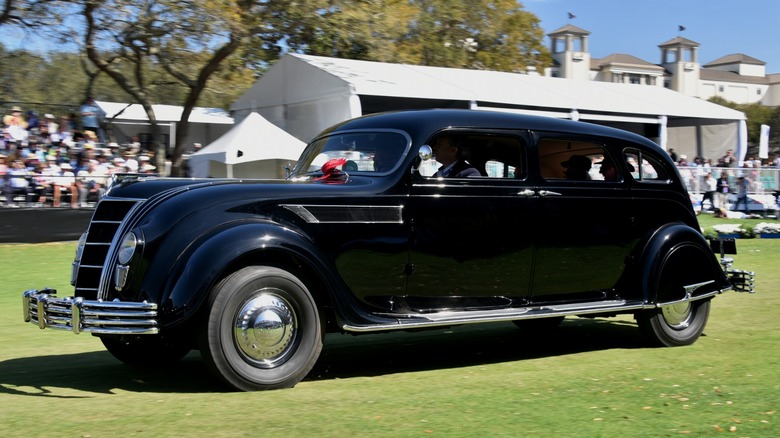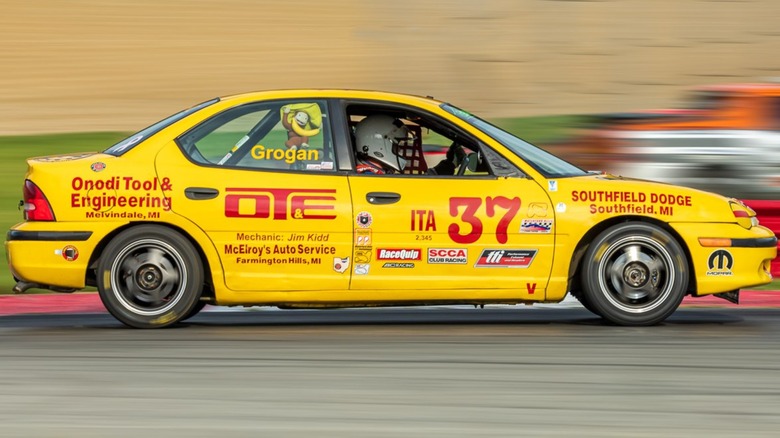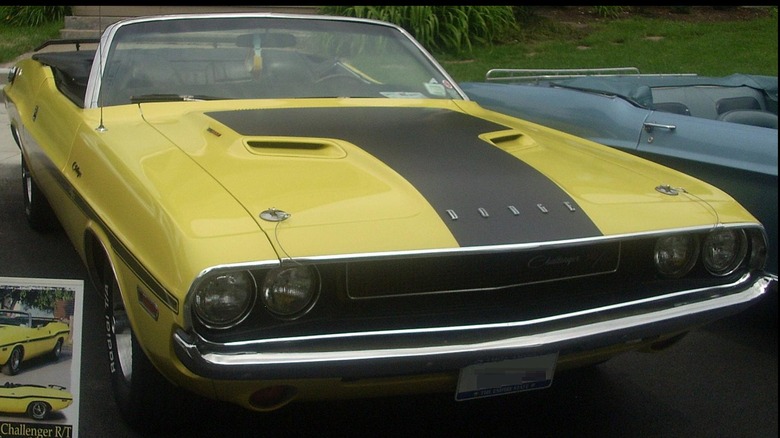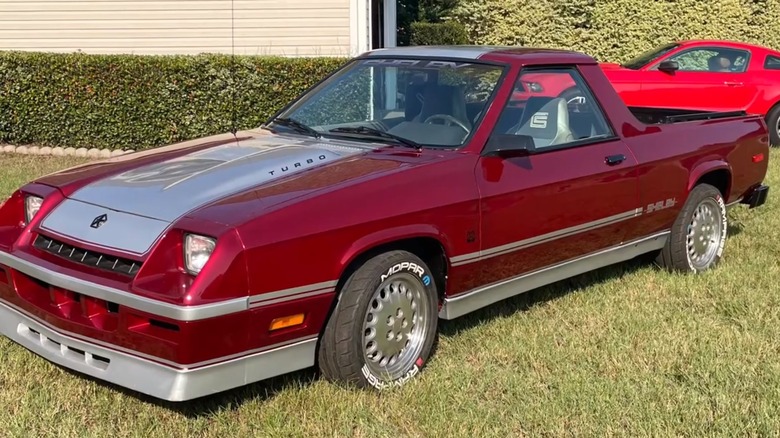10 Super Rare Mopars You Might Never See In Person
In 1937, the Chrysler Corporation introduced its line of OEM parts and accessories under the Mopar name, a brand that owners of Chrysler vehicles could immediately recognize and rely on to know they were buying the correct products for their cars. The first use of the Mopar name was on a can of antifreeze, and while production was soon turned over to war production, it returned to passenger car parts and has been a part of the Chrysler ownership experience ever since. A huge production facility was opened in 1953 in Centerline, Michigan, and continues in operation today.
While Mopar has long been the official line of parts and accessories for Chrysler automobiles, the name has since morphed into an overarching term for the many brands of Chrysler Corporation. These included Chrysler itself, Plymouth, Dodge, DeSoto, and Ram, although Chrysler and its affiliated divisions have undergone plenty of changes over the years.
DeSoto models were discontinued in the 1960s while Plymouth held out until the early 2000s. Ram was split from Dodge into a stand-alone truck division in 2009. Still, a lot of cars with these labels have been built in the century since the first Dodge car left the factory in 1914, which means there is no shortage of Mopar vehicles to be found around the world. Yet, some of them were in limited supply from the start, so here are 10 rare Mopar vehicles you may not ever see yourself.
'Cuda Hemi Convertible
Muscle cars from the golden era — the late '60s — are much more scarce today than they were just 15 or 20 years ago. While they may have been daily drivers then, most are strictly project cars tucked away and hardly driven. However, not all muscle cars of the era are equal — some sold in the millions, while others did not.
Rarity in many car models lies in the details of the original order sheet, which is also what matters most to car collectors with deep pockets. Plymouth's Barracuda model line began in the early '60s, evolving into a muscle car contender opposite the Dodge Challenger within the Chrysler hierarchy. In 1969, Plymouth officially made the sport-oriented version of the model called the 'Cuda, even though it had been a nickname for the model already. Depending on how a new 'Cuda was optioned and whether those options became the most sought-after choices, a particular 'Cuda could become rare and valuable.
The wider and lower E-Body 'Cuda debuted in 1971 and just 12 orders were filled for 'Cuda convertibles. One equipped with the legendary 426 Hemi V8 and A33 Track Pak option, providing a limited-slip Dana differential and heavy-duty engine cooling, went up for sale in 2021. Despite attaining a bid of nearly $5 million, the car failed to meet the receive and went unsold. This is one bad Plymouth Hemi 'Cuda you are not likely to see soon.
Dodge Charger Daytona
Way back when, the cars that went round a NASCAR track were the same thing you could buy from a dealer, not a tube-frame chassis with a fiberglass cover resembling a new car like today. Furthermore, winning NASCAR races was a way for manufacturers to promote their cars and tout their superiority by highlighting the many checkered flags won by a particular model. Dodge was keenly interested in NASCAR in the late '60s, always looking for a way to gain an advantage. Towards the end of the decade, they found one.
The Dodge Charger was just about the most potent car on the track in 1968. Still, managers at Dodge wanted to gain an edge over the competition and set engineers to work. They initially built the Charger 500 with a few aerodynamic tweaks to good results. However, with that success, they added a front nose, huge rear wing, and sir diffusers to prevent lift on a Charger and called it the Daytona. The new car did so well that it ran a 200 mph record and won several races over the next two seasons.
In fact, it did so well that NASCAR banned aero components after just two years of being dominated by the Daytona. Only 503 examples were made to satisfy homologation rules, meaning they are extraordinarily scarce today. Most models you might see in person are custom-made tributes unless you find yourself in a quality museum. They go up for auction occasionally, but you need at least $1 million if you are considering placing a bid.
Chrysler 300-D
In 1955, Chrysler released its new C-300 coupe to dealers. The naming format changed the next year with the 300-B and continued through the alphabet each year through the 1965 300-L. The first significant design change was implemented for the 1958 model year with the 300-D. This was an attractive car with a large open grille and huge fins out back. Engine options included the 392 Hemi and a high-performance option that produced a very healthy 380 horsepower.
The 300-D was a decent seller and not a particularly rare car. Although it sat as a premium Chrysler, nothing makes this model a particular rarity except for one single option. You could order a 300-D with a 390-horsepower Hemi V8 engine, which would be the ultra-rare model because it was the first car to be offered with electronic fuel injection. The Bendix Electrojector used most of the same sensors we have today to function, including an array of sensors and an electric fuel pump.
It functioned using a transistorized computer — which meant that it lacked a microchip as in modern systems — that was made up of capacitors, transistors, and other electrical components. However, it was delicate and engineers failed to test it in real-world conditions. The Bendix system performed poorly to the point that all 35 cars ordered with this option were recalled and retrofitted with carburetors. This makes an all-original fuel-injected 1958 Chrysler 300-D the rarest Chrsyler there is, and you are guaranteed not to see one with all of its original equipment.
[Featured image by Greg Gjerdingen via Wikimedia Commons | Cropped and scaled | CC BY 2.0]
Chrysler Airflow Imperial CV Coupe
Engineers building cars in the early days concentrated on having ample power and reliability, although some also built them to be cost-effective to manufacture. However, the styling of cars paid little attention to anything but how they looked or whether they were functional. However, in 1934 Chrysler built a car that paid attention to its aerodynamic design, and it was something completely different from what could be found at dealers of the day.
Dubbed the Airflow, this Chrysler model strayed from the styling that set a tall and imposing radiator grille at the front of the car by curving the hood back to allow air to slip over the body with reduced drag. It was a great concept but proved ahead of its time as the cars were a sales failure and only lasted a few years. Even though the car was designed using a wind tunnel and featured a new frame that prefaced the proliferation of the monocoque chassis, nothing could save it. The higher production costs -– and corresponding retail price -– amidst the Great Depression certainly did not help.
The most luxurious model was the Airflow Imperial CV-8 Coupe. It came with a big straight-8 engine and a well-appointed and spacious cabin. However, only 212 of these were built, making them among the rarest early Chrysler models and extremely valuable today. You can see one at the Revs Institute in Naples, Florida, but you probably won't encounter one anywhere else.
Dodge Super Bee Hemi
Chrysler unleashed a pair of potent muscle cars in 1968 in the form of the Plymouth Road Runner and Dodge Super Bee. Based on the Dodge Coronet, the Super Bee was added to the lineup as an affordable option for budget power. Before its introduction, high-end performance cars were selling well while the more budget-performance market remained underserved. Both the Road Runner and Super Bee were meant to address this issue and also allowed Plymouth and Dodge to compete head-to-head for the first time.
Heavy-duty suspension and brakes as well as a Hurst Competition Plus shifter on a four-speed transmission came standard on the Super Bee. Red-line wide oval tires also came standard, as did the 335 horsepower 383 V8. Outside, Super Bees came with a wild graphics package, including the unmistakable bumblebee on the rear. Performance was good, with a zero to 60 mph time of 7.1 seconds and a standing quarter-mile taking just 15 seconds flat. For those who wanted more performance, the 425 horsepower Hemi was optional, although its $1,000 price tag countered the budget nature of the car.
The Hemi price must have been a bridge too far for most buyers as only 125 were sold in 1968. In the final year, an even starker option sales gap existed as only 32 hardtops and four coupes were ordered with a Hemi, making them among the rarest muscle cars of all. A 1970 model went up for sale recently on Bring a Trailer but failed to sell despite garnering a bid of $199,999.
Dodge Omni Shelby GLH-S
The Chrysler Corporation narrowly avoided bankruptcy in the late '70s with the introduction of clever new products that helped to drive sales and bring the company back from the brink. After being better placed on sure footing, CEO Lee Iacocca recruited someone he had worked with at Ford to add something extra to his lineup of Chrysler vehicles. That man was Carroll Shelby, and Iacocca knew that he knew how to spice things up in a car.
Dodge produced the Omni hatchback beginning in 1978 from plans that originated in Chrysler Europe for a new small hatchback in line with the most popular cars of that region. These were economy cars that were also incredibly slow. To fix that, Shelby helped engineers tweak the little four-cylinder engines for better output and eventually created the Dodge Omni GLH, which stood for Goes Like Hell. With some exterior flares, limited colors, and blacked-out bumpers, this was America's new hot hatch, and it became a reasonable success.
Before the production of the Omni was wound down completely, Shelby took a limited run of Omni models and tweaked them a little bit more. These would be the Dodge Omni GLH-S, aka Goes Like Hell — Shelby. This car was only produced for the 1986 model year and it was limited to just 500 models. Despite being somewhat rare, prices are still reasonable. One sold recently on Bring a Trailer for $14,999. However, if you weren't the winning bidder, seeing one in person is still unlikely.
DeSoto Adventurer
With production having ended in the '60s, DeSoto is not exactly a well-remembered brand. It initially served as a lower-priced model, but later moved upscale — above Dodge, even. However, as the company emerged in the post-war world, jockeying within the larger Chrysler organization created turmoil that would eventually see the DeSoto name retired for good.
The last few models from DeSoto were attractive and exciting cars, delivering all the same technological achievements as the others while benefiting from chief designer Virgil Exner's adept styling. The DeSoto Adventurer is among the final cars. However, its production coincided with slipping sales of all DeSoto models and they have become rare in the modern age as a result. The Adventurer was introduced in 1956 as a performance hardtop coupe with an available Hemi engine. Sales never exceeded 2,000 units and the model was discontinued in 1960.
For the 1958 model year, only 432 cars left the factory, five of them equipped with the Bendix Electrojector fuel injection system. Of all of those cars, fewer than 100 remain and only one car with the original fuel injection still exists today. This Adventurer with the original Bendix system was restored to its original condition with the painstaking work of getting the fuel injection operating correctly beginning in 1998. That car sold in 2009 for $475,000. With scant information available about it since then, you are likely not seeing it unless you happen to have placed that 2009 bid.
Dodge Neon ACR
Through the decades, Chrysler has created and built many cars that have become desirable and rare, but few would look to the Dodge and Plymouth Neon as an example. Dodge released the speedier Neon SRT-4 from 2003 to 2005, but those are still somewhat common and sold in decent numbers -– up to 13,00 per year –- when new. While special, that is not exactly rare. However, there was a special edition version that is extremely rare today — the Dodge and Plymouth Neon ACR.
Members of the Sports Car Club of America (SCCA) knew the Neon was surprisingly good on the track and they used them for various racing events back in the day. Furthermore, Dodge produced a version of the Neon available to purchase for SCCA events, the Neon ACR. In 1994, it was only available to SCCA members but opened up to anyone the following year. To prep the car for the track, it was stripped of excess weight and given thicker sway bars, four-wheel disc brakes, and adjustable shocks. Sedans received the regular base 132 horsepower engine while coupes could get the 150 horsepower twin-cam option.
The ACR was offered to the public from 1995 through 1999, although nobody knows for sure how many were made. Speculation is that around 4,000 units were produced. Given that these were intended for racing, it is safe to assume they were thoroughly abused, so finding one today could be a tall order.
Dodge Challenger R/T Convertible
Among the legendary Mopar muscle cars, the Challenger is usually top of mind. It was a successful model when it was new and has since become an icon of classic American cars, going so far as to inspire its resurrection as a modern version in 2008. The original Challenger, which debuted in 1970, was a late Mopar entry into the pony car segment that was already dominated by the Mustang and Camaro. However, the Challenger set itself apart with some innovative features, including concealed windshield wipers, flush door handles, and molded polypropylene door panels — an automotive first.
Challengers were available in coupe or convertible form with a choice of nearly every engine Dodge had to offer. Base models received a slant-six with an optional V8 available in sizes from 318 to 440. A special Challenger T/A model made for SCCA racing offered a unique 340 V8 with the Six Pack, a triple two-barrel carburetor setup. While it started with great momentum, selling 83,000 copies in 1970, its star power faded by 1974 when sales fell to just 16,000. Emission regulations and low horsepower figures are likely significant factors in its decline.
With tens of thousands of Challengers sold, it is not a rare Mopar. However, in 1970, one could order a Challenger convertible equipped with a couple of different option packages. Convertibles only represented five percent of overall production, and special packages make them even rarer. In the 1970 inaugural year, only nine customers opted for a drop-top with a Hemi, making the chance you will see one incredibly slim.
Dodge California Shelby Rampage
The early '80s represented an opportunity for Chrysler to try out some new ideas and come up with a variety of novel products. Furthermore, it was also manufacturing its first front-wheel-drive products, implementing the same platform in several models. The K-Car platform practically saved the company from extinction, so Chrysler decided to see what it could do with the Omni's already successful L-Platform.
Two models came from this project, the Dodge Rampage and the Plymouth Scamp, although only one would receive attention from Carroll Shelby. Creating a small truck from the L-Platform was relatively easy due to the lack of a driveshaft and rear end. With all the mechanicals up front, the body in the rear could be anything. This left a useful, reliable, and economical little utility truck perfect for hauling light loads or just getting around town. Unfortunately, the Rampage lacked any guts.
Unlike the Charger, Omni, and Daytona, Dodge never officially released a Shelby Rampage. Instead, dealerships in California ordered the trucks from the factory, which were then sent to Santa Fe to be outfitted with special parts from Shelby and Direct Connection, a specialty Mopar parts line, and then sent to dealers in California only. About 250 of these trucks were ordered, making them especially rare and an unusual sight today.










